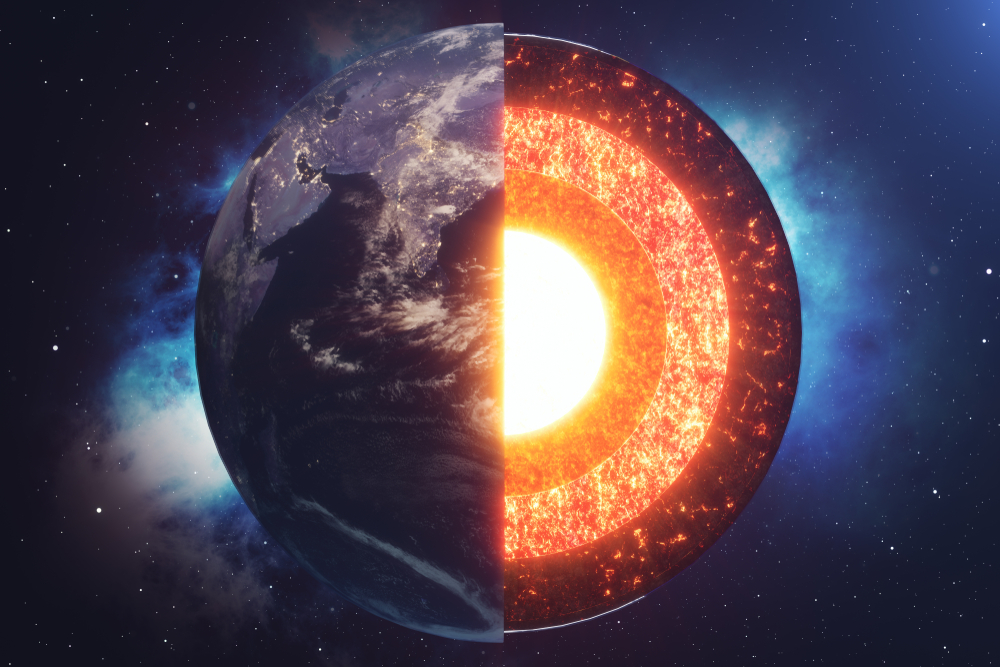Earth’s Inner Core Is Slowing Down — and May Not Be Entirely Solid
Posted on Categories Discover Magazine

A recent study revealed that Earth’s inner core is slowing down, prompting scientists to investigate further. Their research led to an unexpected discovery: that inner core is not entirely solid.
Scientists from the University of Southern California (USC) analyzed data from earthquakes and identified unexpected changes in the core’s composition, offering insights into why these shifts are occurring.
A Slowing Core and Its Effects
In June 2024, USC scientists published a study showing that Earth’s inner core has been slowing since 2010. This deceleration slightly affects the planet’s rotation, leading to marginally longer days.
“It’s very hard to notice, on the order of a thousandth of a second, almost lost in the noise of the churning oceans and atmosphere,” explained John Vidale, Dean’s Professor of Earth Sciences at USC Dornsife College.
Previously, the inner core was believed to be a solid iron-nickel sphere surrounded by a liquid iron-nickel outer core, which generates Earth’s magnetic field. Vidale suggests that interactions with the molten outer core and gravitational forces from the mantle contribute to the slowing of the inner core.
Read More: How We Know What’s Deep Inside the Earth, Despite Never Traveling There
A Surprising New Discovery
Further analysis revealed another unexpected finding: “I was analyzing multiple decades’ worth of seismograms, one dataset of seismic waves curiously stood out from the rest,” Vidale noted in a press release. “Later on, I’d realize I was staring at evidence the inner core is not solid.”
A follow-up study in Nature Geoscience reports viscous changes near the inner-core boundary, likely caused by interactions between the inner and outer core due to variations in mantle density and convection currents. That was an accidental discovery as the researchers did not initially intend to redefine the inner core’s physical state.
How Scientists Study Earth’s Core
Since drilling to the core is impossible, scientists rely on seismic waves from earthquakes to study its properties.
For these studies, researchers studied PKIKP waves — seismic waves that pass through both the outer and inner core before being recorded and analyzed by seismic monitoring stations. They examined earthquake data from the uninhabited volcanic South Sandwich Islands in the Atlantic Ocean, focusing on 121 quakes recorded between 1991 and 2024 by seismic arrays in Eielson (ILAR) and Yellowknife (YKA) in North America.
The great distance between the earthquake source and the seismic stations was necessary to ensure that the waves traveled through the earths inner core, allowing researchers to extract meaningful data about its composition and structure. These distant locations act like a “lens” that captures waves traveling the longest and most informative paths.
By comparing repetitive earthquakes over time, scientists identified variations in seismic wave behavior. One dataset from the Yellowknife station contained seismic wave properties never observed before. Only after refining resolution techniques did the team realize these waveforms indicated additional physical activity within the inner core.
Why the Core Is Changing
Findings from both studies suggest that the molten outer core is driving these changes. Its turbulent motion not only slows the inner core but also alters its composition, marking the first observed shift of this kind on a human timescale.
These discoveries advance our understanding of Earth’s rotation, magnetic field, and thermal dynamics. They provide another key piece in unraveling the complex interactions between geological activity and the planet’s spin.
Article Sources
Our writers at Discovermagazine.com use peer-reviewed studies and high-quality sources for our articles, and our editors review for scientific accuracy and editorial standards. Review the sources used below for this article:
Having worked as a biomedical research assistant in labs across three countries, Jenny excels at translating complex scientific concepts – ranging from medical breakthroughs and pharmacological discoveries to the latest in nutrition – into engaging, accessible content. Her interests extend to topics such as human evolution, psychology, and quirky animal stories. When she’s not immersed in a popular science book, you’ll find her catching waves or cruising around Vancouver Island on her longboard.